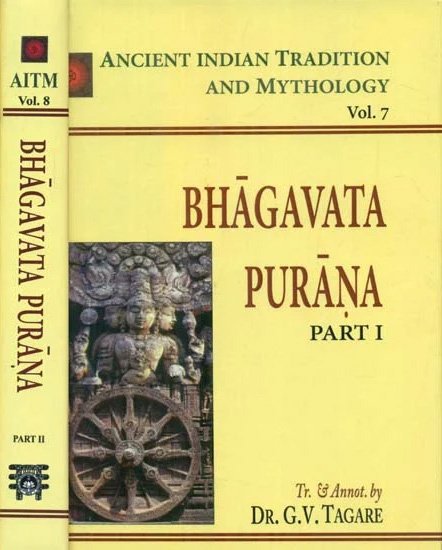The Bhagavata Purana
by G. V. Tagare | 1950 | 780,972 words | ISBN-10: 8120838203 | ISBN-13: 9788120838208
This page describes Description of Vishnupada (the position of Dhruva) and Shishumara-cakra which is chapter 23 of the English translation of the Bhagavata Purana, one of the eighteen major puranas containing roughly 18,000 metrical verses. Topics include ancient Indian history, religion, philosophy, geography, mythology, etc. The text has been interpreted by various schools of philosophy. This is the twenty-third chapter of the Fifth Skandha of the Bhagavatapurana.
Chapter 23 - Description of Viṣṇupada (the position of Dhruva) and Śiśumāra-cakra
[Sanskrit text for this chapter is available]
Śrī Śuka said:
1. Now at a height of thirteen lakh Yojanas above the Ursa Major, lies what they call the highest abode of Viṣṇu. Here dwells the Supreme Votary of the Lord Dhruva, the son of Uttānapāda. The stars presided over by Agni, Indra, Kaśyapa Prajāpati and Dharma respectfully go round him keeping him on their right,—all moving simultaneously (as stars). He is still the support of those whose span of life is upto the end of a Kalpa (till the time of deluge).
2. He (Dhruva) alone shines perpetually as he is decreed by God to support like a post all the hosts of luminaries, planets, constellations of stars, etc. which are set in motion by the ever vigilant almighty Time of incomprehensible velocity.
3. Just as oxen, employed in treading ears of corn, are tied to the post in the middle of the threshing ground, with strings short, long and medium in length, walk round in their respective spheres in three circles (at a distance of short, long and midway between the two according to the length of the string with which they are fastened), similarly posts of celestial bodies, planets etc., fastened to the Wheel of Time in the inner circle or in the outer circle, and impelled by the Wind (called Pravaha in supra 21.8), and with Dhruva (the Polar Star) as their support (central pivot), go on revolving to the end of the Kalpa, in three courses (marked by the periods of Uttarāyaṇa or northerly course, Vaiṣuvata i.e. along with the equator and Dakṣiṇāyana or Southward course). Just as clouds and birds like hawks with the support of air and piloted by their past actions move about (afloat) in the sky, similarly, the host of these heavenly luminaries which are jīvas which are favoured with those shining bodies by the union of matter and spirit and whose velocities (and directions of motions) are controlled by their past actions, do not fall to the ground.
4. Some persons describe this system of heavenly luminaries as being supported by the mystical Yogic powers of Lord Vāsudeva who has assumed the form of a Gangetic porpoise.
5. The Pole-star is located at the end of the tail of this porpoise that lies coiled with its headdownward. (Just below it) on the tail are located the four stars called Prajāpati (the sage Kaśyapa) Agni (the Fire-god), Indra (the King of gods) and Dharma (the presiding deity of righteousness). At the root of the tail, are fixed the star, Dhātā and Vidhātā, and the Seven Sages (the Ursa Major) on the hip; on the right side of its body which coils from left to right are located the fourteen constellations of Stars (from Abhijit to Punarvasu which mark the northern course (Uttarāyaṇa) and the fourteen constellations marking the Southern Course (Dakṣiṇāyana)—viz. from the Puṣya to Uttarāṣāḍhā—are located on its left side. This is just like the porpoise whose coiled body has equal number of members on its either side. (He mentions further details of the positions of the constellations:). On its back is the Ajavīthī (the group of constellations called Mūla, Pūrvāṣāḍhā and Uttarāṣāḍhā) and the heavenly Ganges (the Milky Way) is at its belly.
6. (The constellations) Punarvasu and Puṣya are located on its right and left loins; Ārdrā and Āśleṣā on its right and left hind-legs; Abhijit and Uttarāṣāḍhā on its right and left nostrils; Śravaṇa and Pūrvāṣāḍhā at its right and left eye respectively while Dhaniṣṭhā and Mūla are at its right and left ears. (The group of) eight constellations beginning from Maghā, which mark the Southern Course (Dakṣiṇāyana) are located on the ribs of its left side while the eight constellations from Mṛgaśīrṣa (the Orion) and others marking the northern course (Uttarāyaṇa) are on its ribs on its right side, but in the reverse order (i.e. from Pūrvābhādrapadā to Māgaśīrṣa [Māgaśīrṣa?]). One should locate the remaining two. viz. Śatabhiṣā or Śatatārakā and Jyeṣṭhā on its right and left shoulders.
7. (One should locate) the star Agasti on its upper chin and (the star called) Yama on its lower chin; the Mars in the mouth and the Saturn on its generative organ and the Jupiter on its hump, the Sun on its chest and Nārāyaṇa at the heart; the Moon in the mind; the Venus in the navel, the pair of Aśvinīkumāras on the nipples (of its chest), the Mercury in its inhalation and exhalation, (the shadow-planet) Rāhu at the throat and Ketus at all members of the body and the (remaining) stars all over the hairs of its body.
8. This is verily the manifestation of the form of glorious Lord Viṣṇu consisting of all gods. Silently and with concentration of mind one should watch it every evening and adore it with the following Mantra:
“We bow to the Supreme Personage, the Lord of all gods, (who assumed the form of) the Time Wheel, the support of all heavenly bodies, We meditate upon him.”
9. This form of the Supreme God embodying all planets, constellations of stars and other heavenly luminaries washes off the sins of those who repeat the above Mantra three times (morning, mid-day and evening) a day. The sin committed in the past, present and future of a person who bows to him or remembers him three times a day is destroyed immediately.
